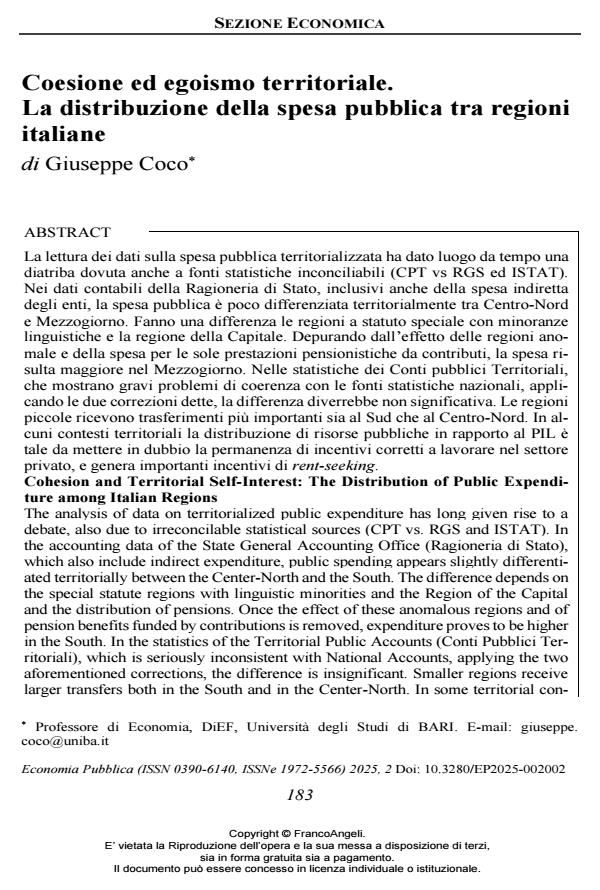Cohesion and Territorial Self-Interest: The Distribution of Public Expenditure among Italian Regions
Journal title ECONOMIA PUBBLICA
Author/s Giuseppe Coco
Publishing Year 2025 Issue 2025/2
Language Italian Pages 20 P. 183-202 File size 309 KB
DOI 10.3280/EP2025-002002
DOI is like a bar code for intellectual property: to have more infomation
click here
Below, you can see the article first page
If you want to buy this article in PDF format, you can do it, following the instructions to buy download credits

FrancoAngeli is member of Publishers International Linking Association, Inc (PILA), a not-for-profit association which run the CrossRef service enabling links to and from online scholarly content.
The analysis of data on territorialized public expenditure has long given rise to a debate, also due to irreconcilable statistical sources (CPT vs. RGS and ISTAT). In the accounting data of the State General Accounting Office (Ragioneria di Stato), which also include indirect expenditure, public spending appears slightly differentiated territorially between the Center-North and the South. The difference depends on the special statute regions with linguistic minorities and the Region of the Capital and the distribution of pensions. Once the effect of these anomalous regions and of pension benefits funded by contributions is removed, expenditure proves to be higher in the South. In the statistics of the Territorial Public Accounts (Conti Pubblici Territoriali), which is seriously inconsistent with National Accounts, applying the two aforementioned corrections, the difference is insignificant. Smaller regions receive larger transfers both in the South and in the Center-North. In some territorial contexts, the distribution of public resources relative to GDP is such as to cast doubt on the persistence of proper incentives to work in the private sector, and it generates significant rent-seeking incentives
Keywords: public expenditure, cohesion, Mezzogiorno, fiscal residuum.
Jel codes: H76, R10
- Bianchi L. & Fraschilla A. (2020). Divario di cittadinanza - Un viaggio nella nuova questione meridionale. Soveria Mannelli: Rubbettino.
- Bodo G. & Viesti G. (1997). La Grande Svolta: il Mezzogiorno nell’Italia degli anni ’90. Roma: Donzelli.
- Cassese S. (2016). Lezioni sul Meridionalismo. Nord e Sud nella Storia d’Italia. Bologna: il Mulino.
- Accetturo A., de Blasio G. & Ricci L. (2014). A tale of an unwanted outcome: Transfers and local endowments of trust and cooperation. Journal of Economic Behavior & Organization, 102(C): 74-89.
- Accetturo A., Albanese G., Torrini R., Depalo D., Giacomelli S., Messina G., Scoccianti F. & Vacca V. P. (2022). The North-South gap: economic development and public intervention, Workshop and Conferences 25, Bank of Italy, Economic Research and International Relations Area.
- Banca d’Italia (2014). Economie regionali – L’economia delle regioni italiane, Dinamiche recenti e aspetti strutturali, 43 – dicembre 2014.
- Banca d’Italia (2016). Economie regionali – L’economia delle regioni italiane, Dinamiche recenti e aspetti strutturali, 43 – dicembre 2016.
- Banca d’Italia (2020). Economie regionali – L’economia delle regioni italiane, Dinamiche recenti e aspetti strutturali, 22 – novembre 2020.
- Cerniglia F. (2007). La Spesa Pubblica in Italia: articolazioni, dinamica e un confronto con altri paesi. In: Quadrio-Curzio A. & Fortis M (a cura di). Valorizzare un’economia forte: l’Italia e il ruolo della sussidiarietà. Bologna: il Mulino.
- Coco G. & De Vincenti C. (a cura di) (2020). Una questione nazionale- Il Mezzogiorno da “problema” a “opportunità”. Bologna: il Mulino.
- De Angelis I., de Blasio G. & Rizzica L. (2020). Lost in Corruption. Evidence from EU Funding to Southern Italy. Ital Econ J, 6: 355-377.
- De Simone E. & Liberati P. (2020). Does redistribution matter? The decomposition of the fiscal residuum in Italian regions. Regional Studies, 54(3): 296-307. DOI: 10.1080/00343404.2019.1603367
- Di Caro P. & Fratesi U. (2019). Investigating the spatial patterns of regional fiscal residua in Italy. Politica economica, 35(3): 367-394
- Esposito M. (2024). Zero al Sud. La storia incredibile (e vera) dell’attuazione perversa del federalismo fiscale. Soveria Mannelli: Rubbettino.
- Galli G. & Gottardo G. (2020). La distribuzione della spesa pubblica per macroregioni. Osservatorio CPI.
- Giannola A., Petraglia C. & Scalera D. (2016). Net fiscal flows and interregional redistribution in Italy: A long-run perspective (1951-2010). Structural Change and Economic Dynamics, 39: 1-16.
- Arcano R., Capacci A. & Galli G. (2024). I residui fiscali: più trasparenza migliorerebbe il dibattito sulle autonomie. Osservatorio CPI -- https://osservatoriocpi.unicatt.it/ocpi-pubblicazioni-i-residui-fiscali-piu-trasparenza-migliorerebbe-il-dibattito-sulle-autonomie.
- Petraglia C. & Scalera D. (2019). Interregional Net Fiscal Flows in Years 2007-2015. Italy and Germany at the Mirror. Politica Economica, 2. DOI: 10.1429/94538
- Viesti G. (2023). Contro la secessione dei ricchi. Autonomie regionali e unità nazionale. Bari-Roma: Laterza.
- Trigilia C. (1992). Sviluppo senza autonomia. Bologna: il Mulino/contemporanea 54.
- Staderini A. & Vadalà E. (2009). Bilancio pubblico e flussi redistributivi interregionali: ricostruzione e analisi dei residui fiscali nelle regioni italiane. In: Banca d’Italia (a cura di). Mezzogiorno e politiche regionali.
- Villari R. (1961). Il sud nella storia d’Italia. Bari: Laterza.
- Volpe M. (2019). Regionalismo differenziato: quali numeri a supporto di un dibattito solido e informato. Rivista giuridica del Mezzogiorno, 4.
Giuseppe Coco, Coesione ed egoismo territoriale. La distribuzione della spesa pubblica tra regioni italiane in "ECONOMIA PUBBLICA " 2/2025, pp 183-202, DOI: 10.3280/EP2025-002002